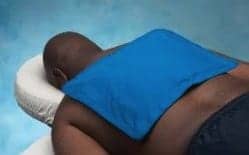
An ONR-supported researcher tests the Mobile, Virtual Enhancements for Rehabilitation (MOVER) software system. MOVER provides traumatic brain injury patients with a way to engage in virtual physical therapy regimens at home. (Photo courtesy of the US Department of Defense science blog)
The Office of Naval Research (ONR) is developing what it calls the Mobile, Virtual Enhancements for Rehabilitation (MOVER), to be used as a home-based therapy aid for veterans recovering from traumatic brain injuries (TBI).
According to a science blog on the US Department of Defense website, the MOVER was developed as a safe, engaging, and easy way to help TBI patients maintain therapy regimens at home that they were previously engaged in at a treatment facility.
As explained in the blog, the MOVER is a software system that can be installed on any laptop or desktop PC equipped with a camera function. To operate the MOVER, the user turns on the computer and camera, stands still, and the software maps out a virtual “skeleton” on screen.
The skeleton consists of brightly colored lines and shapes that mirror the person’s movements through each exercise.
During sessions with the MOVER, pop-up text boxes or color shading appear in certain areas of the virtual skeleton to coach the user about proper movements and technique, and how to correct them, the blog continues.
“Eventually, we want to improve the virtual coaching so it provides commands and encouragement to users vocally and they in turn can respond back,” says Dr James Niehaus, a scientist at Charles River Analytics Inc, the lead company working with ONR to develop the MOVER software, in the blog.
“There are times when you don’t feel motivated to work out,” says Lt Cmdr Brent Olde, a program officer in the Human and Bio-Engineered Systems division of ONR’s Warfighter Performance Department, per the blog.
“You also risk hurting yourself by exercising incorrectly. That applies to everyone, healthy or not. Now imagine how much harder it is for someone with a brain injury. They may need help, which is where MOVER comes in,” he adds.
According to the blog, exercises that are part of the MOVER software are standard for TBI therapy and include lunges, knee raises, and squats. The MOVER tracks the TBI patient’s progress with these exercises, which can then be reviewed with the physical therapist.
Later this year, the blog notes, Niehaus plans to launch a study of the MOVER technology among TBI patients at Spaulding Rehabilitation Hospital.
[Source: US Department of Defense]





